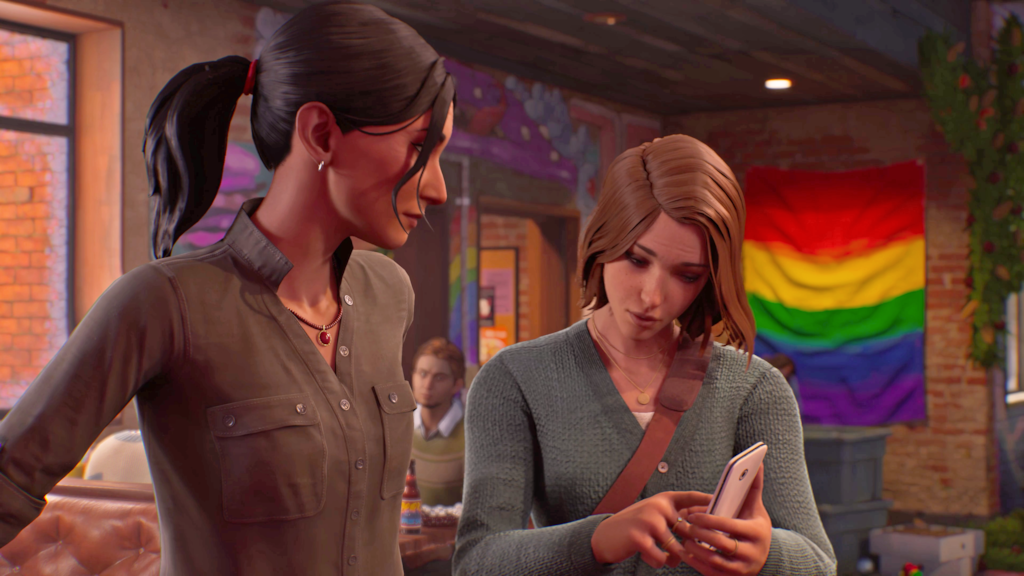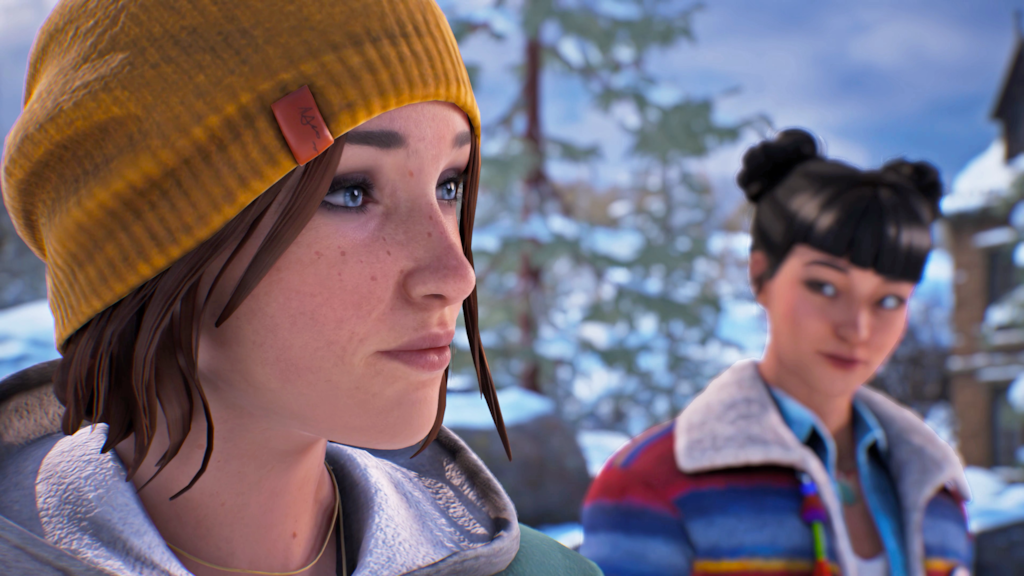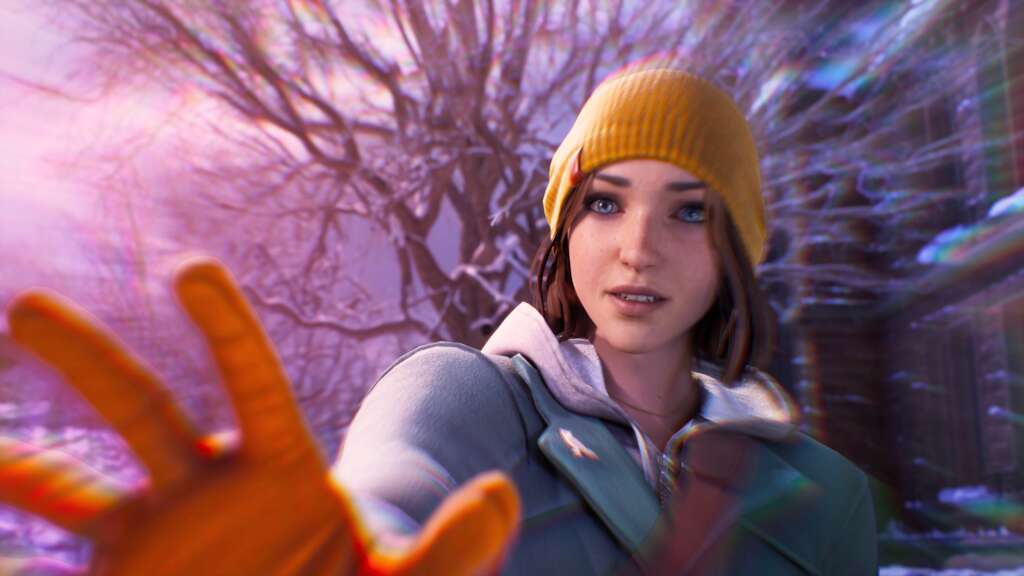It only feels right to begin this review with a confession: I am not someone who saw good reason for there to be a follow-up to the original Life is Strange game. I felt that way when Beyond the Storm was announced, and I felt that way again when Deck Nine revealed they would be continuing Max Caulfield’s story with Life is Strange: Double Exposure. Though I enjoyed the first game well enough, I felt as if the ensuing titles that both Don’t Nod and Deck Nine worked on–such as Life is Strange 2, Life is Strange: True Colors, and Tell Me Why–explored more interesting topics and boasted more compelling protagonists. To me, Max always felt a bit overshadowed by those around her–characters with intense flaws and strong personalities that drove the game’s plot and imbued emotion into the story. And after playing Life is Strange: Double Exposure, and despite having high hopes that it might persuade me, I unfortunately still feel the same.
In Life is Strange: Double Exposure, Max once again feels only as interesting as the characters surrounding her, making her a driving force that isn’t particularly compelling and a fairly flat protagonist. Even as the game explores her grief following the loss of Chloe (either via a painful fall-out or her death, depending upon your selection) and a new loss that occurs during Double Exposure’s opening chapter, Deck Nine stumbles in giving these processes depth and emotional resonance.
Despite this weak thread, Double Exposure is, admittedly, a visually impressive game with some well-executed narrative beats, an interesting twist on gameplay, and some endearing characters. However, it ultimately feels too similar to its predecessor in a few frustrating ways and suffers from inconsistent story quality and writing; this makes for an overall experience that lacks a lot of depth and falls short.
Set a decade or so after the events of Life is Strange, Double Exposure follows Max–now an award-winning photographer–during her residency at Vermont’s prestigious Caledon University. You soon learn that in the years between the first game and this new adventure, Max has suppressed her ability to time-travel, as she is now all too aware of the damage it can inflict. We are also quickly introduced to Max’s two closest friends, the bold and charismatic poet Safi Llewellyn-Fayyad and meek geek-turned-astrophysicist Moses Murphy. Yet by the time the first chapter comes to a close, any sense of normalcy has been stripped away as we find Max thrust into a new traumatic situation: the sudden, violent death of one of Caledon University’s most-beloved students.
Ever the detective, Max takes it upon herself to figure out what happened. This is largely prompted by her discovering a new power that gives her a decisive edge in getting to the bottom of things: the ability to warp between universes. Double Exposure, as its name slyly implies, sees Max venture back and forth between two in particular. In the first of these universes, the student who was killed remains dead, forcing Max to navigate both her own grief and how a sudden loss can shake a community. In the other, however, the character is miraculously alive, albeit still in grave danger. The process of crossing between these two dimensions is what drives much of Double Exposure’s gameplay; Whenever Max hits a dead end in one universe, she is prompted to travel to the other, where she may find key pieces of information, important items, or ways to circumvent physical barriers that exist in the other realm.
The decision to add this mechanic rather than solely relying upon Max’s ability to time travel is a good one; It’s fun and changes things up just enough from the original Life is Strange while still feeling in line with Max’s pre-existing power. However, her immediate use of it with next to no hesitation did feel a bit off, considering her acute awareness of the disaster her time-traveling wrought. Though the player is largely responsible for Max’s actions and beliefs, this is a recurring issue in Double Exposure, as Max ultimately comes across as having no real convictions or personality outside of a fondness for delivering Gilmore Girls-esque pop culture quips.

Furthermore, this dimension-hopping feels far more inconsequential than Max’s time-traveling in Life is Strange, as it essentially just allows Max to have conversations using supernaturally accrued knowledge and snoop around offices. Perhaps this then explains her leniency with it, though I’d argue the damage it does to the overall experience is more important than justifying her nonchalance.
Whereas the original game leaned a bit too hard into Degrassi-style melodrama, the stakes were much greater and tense situations were plentiful, ultimately making for a more compelling experience. Though Double Exposure has some stellar dramatic moments, a couple that hit home, and a few interesting twists, they are few and far between. And more frustratingly, there exist a few moments that should have been more dramatic, given the ongoing situation, but simply aren’t.
Another factor that leads to this disconnect and the game’s overall lack of passion, for lack of a better word, comes from the fact that Max’s relationships with all of Double Exposure’s characters–and even Caledon University a whole–feel distant.
Whereas Arcadia Bay felt like a home and its residents, part of a community, walking through Caledon University reminded me of visiting a college campus during the holidays: quiet and almost liminal. Though I enjoyed some of the campus’ faculty members, particularly the creative non-fiction professor Gwen, interactions with her felt largely stilted and her story did not go anywhere particularly interesting.

The game’s two romantic options, Amanda and Vinh, are forced and half-baked. While Amanda is a sweetheart, the quirky bartender ends up feeling more like someone who is merely around, as she doesn’t have much of a role in the game and doesn’t feel like someone Max is particularly drawn to. A lot of the time they spend together feels almost awkward, and some moments–such as Max suggesting she spend the night after a quick kiss–come off as bizarre given the majority of their interactions have involved Amanda being irritated at Max blowing her off, or her trying to give Max space to grieve. Vinh, on the other hand, plays a larger role in the narrative and does have his own vulnerabilities that are teased out through the game. But he is also essentially a frat bro who repeatedly hits on Max until you can choose to be endeared (or worn down) by him.
And despite being told Safi and Moses are close friends, you don’t see her exhibit a deep connection to either of them. There are certain things you’d think she’d know about her companions and plenty of things you’d think they’d know about her, even outside of her tragic past and powers. This is made more disappointing because Safi and Moses are two of the game’s most interesting characters. Safi in particular has a lot of personality, a compelling backstory, and plenty of connections to the game’s major players; she ultimately drives the game forward which, while not a problem in itself, makes for yet another side character who completely overshadows Max. And I understand that part of this is intent, I really do. But it is frustrating, in a narrative-heavy, emotional game, to feel like I am controlling a vehicle rather than a character.
Another issue with Safi outshining Max is that, in many ways, it makes it entirely clear that Double Exposure is largely a retread of Life is Strange. It’s a bit awkward, considering Deck Nine is developing the title rather than original studio Don’t Nod. But even if I place that bit of distaste aside, it was strange as a player. I don’t want to give away major plot points, but suffice to say that if I described in broad terms the plot to both games–relatively spoiler-free highlights being a school-based murder mystery, a looming storm, and an angsty female friend with issues and dead best friend shrouded in mystery–you’d be hard pressed to narrow down which Life is Strange I’m talking about.
The relationship that felt the most tangible and real to me, strangely enough, was one that was barely seen throughout the game and has caused some outrage from the original game’s fans: Max’s relationship with Chloe. You won’t see much of this play out if you state that Chloe died in the first game–and to be honest, you still won’t see much even if you select that she survived. That said, there was something that felt so real about the pair having drifted off, their trauma bond over enduring such a life-altering series of events proving not quite enough to keep two people with such drastically different wants and personalities together.
You see Chloe online on social media, even posting on occasion. She sends over the occasional text and checks in on you after seeing a troubling news report, proving that despite their differences, she will always care for Max. Whereas some found Chloe’s lack of a place in Max’s life somewhat insulting, I couldn’t help but relate to that sort of bittersweet dynamic, having been in relationships like that before. Though she is not around, Chloe serves as a sort of shadow that hangs over Max, which is precisely what I’d expect.

Double Exposure also deserves praise for its visuals and motion-capture, both of which are improved from previous Life is Strange titles. Better lighting and motion-capture technology that is able to replicate micro-expressions beautifully make for a heightened sense of realism, and allow the game to convey greater emotion than its stiff predecessors. However, the studio makes the smart call to not lean too far into that realism, ultimately favoring the series’ tendency towards more stylized characters and high-saturation environments. Though I might not have loved much of the story, I was drawn into Double Exposure’s world through its art.
I also think–and I urge you to skip this paragraph if you wish to avoid larger spoilers!–that where Double Exposure leaves things and expands the wider Life is Strange universe makes for an exciting promise. In fact, it’s so interesting–and pertinent to my overall feelings–that it feels important to bring up in spite of how hard I’ve tried to keep this all spoiler-free. In the same way that Remedy’s Control made it clear that the events in Alan Wake, and Alan himself, are not these isolated forces, we see that sort of fun realization occur in this game as well. This also wonderfully harkens back to Life is Strange 2, which began to set up this premise. Though I wasn’t thrilled to see “Max Caulfield will return” at the end of the game, the path that two other characters embark upon is compelling and makes me interested in a spin-off title following one or both of them. Suffice to say, I see the potential for a real Magneto-Xavier dynamic in the future, and I think that could be a fantastic place for the series to go.
And yet, potential for a more interesting story doesn’t quite improve the overall experience Life is Strange: Double Exposure. There’s a part of me that wonders if going into the game with a greater fondness for the original would have made the experience more enjoyable. There’s another part of me that wonders if the opposite is true, and I’d have been better coming in without ever having experienced the first game. But as both a continuation and a separate title, Double Exposure seems to fall short. Though it offers some interesting narrative beats, great visuals, and a few endearing characters, it fails to deliver the personality, drama, or emotion it is utterly reliant upon.
